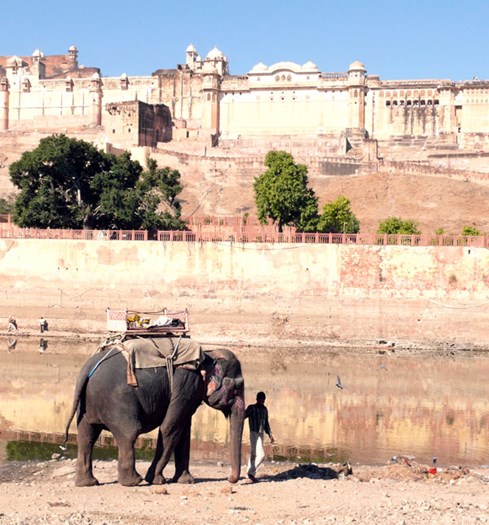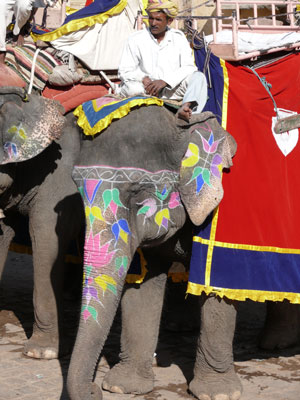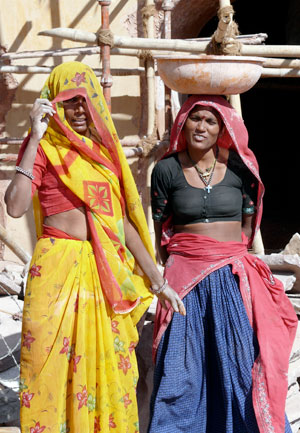JAIPUR, RAJASTHAN - The narrow, winding trail leading to the iconic fort was crowded with a parade of elephants, all carrying Tilly-clad tourists to the majestic medieval castle that sits in a stone valley, 11 kilometres from downtown Jaipur, which is known as the Pink City of Rajasthan.
The elephant’s name mattered not - the task he faced was certainly Herculean, though. The 12th century fort sits on a steep terraced plateau below the protective visage of Jaigarh Fort - home to the world’s biggest cannon - and it takes all one’s strength to reach it by foot.
"You can walk, take a Jeep or ride an elephant to the gates of Amber Fort," a guide had told us.
We opted to hitch a ride on Hercules, the Asian elephant whose long snout was painted bright colours, a tradition that dates back over 600 years when the Kachchwaha Dynasty set up their home here and decorated their pet behemoths for the local Elephant Festival, which is still held annually.
As we swayed back and forth atop the mighty beast, perilously close to the edge of a steep incline that dropped dozens of metres straight down to an almost dry Maota Lake, we wondered if we’d made the right decision. The rider didn’t make us feel any better when he mentioned: "Elephant trampled tourist last week. Very frightening."
As Hercules lumbered up the road, hawkers gave chase, offering to sell us local crafts.
"Throw money - I give you shoes," said a young man who flashed a pair of colourful leather slippers known as "jooties" that the skilled craftsmen of this region make.
This parched region of India is where people, especially the women, compensate for a lack of natural colours by dressing in brightly decorated shoes (jooties), long skirts (lehanga) or blouses (kurta) that are enlivened by a riot of greens, reds, yellows, pinks and blues.

Left: Amber Fort is located outside the Pink City of Jaipur.
The two small towns you pass to get to Amber Fort, Sanganer and Bagru, are also noted for their block printing textiles, wherein wooden blocks carved with floral and geometric patterns and symbolic motifs are dipped in dyes made from extracts of flowers and minerals and then hand printed and dried. The results are quite spectacular.
With all the sales activity around us, we hadn’t noticed that Hercules had arrived at the fort’s arched gateway, known as Surajpol, that leads into the Jaleb Chowk, a grand courtyard now filled with souvenir shops.
Amber Fort is one of India’s most visited sites. Its treasures include Shila Devi Temple, located in the main courtyard, which enshrines the war goddess Kali and whose beautifully-carved silver doors are stunning.
A second courtyard contains the spectacular Diwan-i-Am, an open pavilion with a double row of marble and red sandstone pillars with finely carved elephant brackets, frescoes and latticed galleries - all designed in the Mughal influence.
The most beautiful spot in the fort to us was the Ganesh Pol, a two-storey ceremonial gateway embellished with floral motifs, beautiful glass mosaic frescoes, latticed stone galleries and a painting of Lord Ganesh, the god of learning and good fortune.
The walls of a room known as the Sheesh Mahal were decorated with thousands of tiny mirrors that sparkle like stars when candles are lit inside the marble chamber.
From the fort’s walls one gets a breathtaking view of the surrounding brilliance, highlighted by the dramatic Aravalli Hills, thought to be the oldest in the world.


Left: The elephants have their snouts painted in traditional bright colours. Right: Women wear brightly coloured clothes, even when working.
The trip to and from Amber Fort took us though a series of villages and arid desert land, which Rajasthan state is noted. The villages are home to Rajput women, who enhance their natural beauty with heavy chunky jewellery made of bronze, silver and gold. The decorations also signify ones financial status among the villagers.
Exquisitely-crafted kundan jewellery embedded with gems and intricate enamel work on different metals is a highly-skilled craft honed over centuries by the village women, which now become treasured souvenirs for tourists.
Amber Fort is continually under repair, its fragile stone and mud facade under constant attack from the blistering sun. An army of workers, mostly women decked out in bright, colourful clothes, do most of the repair work, carrying heavy bowls filled with cement and rock on their heads.
They stop every so often to watch the clumsy tourists dismount the elephants and shyly pose for photographs. They are the guardians of one of India’s most treasured icons.
About the Author
Marc Atchison is a veteran journalist and a seasoned traveller with more than 20 years of travel writing experience. As the former Travel Editor of the Toronto Star, Canada's largest newspaper, and now Editor-in-Chief and Senior Writer for TraveLife magazine (Canada) and travelife.ca, Marc has been to over 100 countries in the world. Japan is one of his favorite destinations and he's been there on numerous occasions.